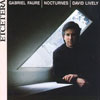Fauré Nocturnes
View record and artist detailsRecord and Artist Details
Composer or Director: Gabriel Fauré
Label: Etcetera
Magazine Review Date: 9/1990
Media Format: CD or Download
Media Runtime: 78
Mastering:
DDD
Catalogue Number: KTC1082

Tracks:
| Composition | Artist Credit |
|---|---|
| (13) Nocturnes |
Gabriel Fauré, Composer
David Lively, Piano Gabriel Fauré, Composer |
Author: Lionel Salter
David Lively, an American pianist now living in France, has impressive credentials: one of Arrau's few pupils, he has been a prizewinner at several international competitions, has played with the Melos Quartet, and directs a festival at Saint-Lizier (in the Pyrenees), where this disc was made. He is technically very assured and, as can be heard here, shows great sensitivity to dynamic nuance and tonal colour. Yet despite his evident sensibility and seriousness, and some quite beautiful pianism qua pianism (caught with fidelity by the rather forward recording), not all these Nocturnes strike me as entirely idiomatic. Faure's pupil and disciple Roger-Ducasse, in his preface to the printed edition, mentions the composer's fears that performers would misinterpret and exaggerate any markings of rubato, and therefore completely avoided indicating it throughout the set.
When reviewing Paul Crossley's CRD recording, MEO, while rightly recognizing his musicianly qualities, was just a little troubled by some over-insistent treatment and some rubato. David Lively's sense of scale is well judged: he is considerably less vehement (if less atmospheric) in the sequence-ridden Nos. 9 and 10, produces clarity in the agitated central section of No. 5, and (as in the classic Decca recording by Kathleen Long—nla) adopts a lighter tone, with less pedal, in the stormy middle of No. 2; he also pedals the austere No. 7 more cleanly. But in the earlier Nocturnes he is often unwilling to be simple and direct, and, seeking to underline every emotional or harmonic point, adopts extremely free rubato—as at the very opening of No. 1 and of No. 3 (which is intrinsically complex enough rhythmically): the phrase-shape at the start of No. 4 is downright distorted. Yet elsewhere, and especially in the later pieces, he adopts a cooler, more straightforward reading than Crossley (as for instance in the outer sections of No. 6, of which he gives an outstanding performance) and so accords better with what we have traditionally understood as true Faure style. In general his speeds tend to be slightly faster than Crossley's, but only in the swaying barcarolle-like No. 8, which after all is marked Adagio (even if non troppo), does he seem to be forcing the pace. A somewhat variable set, then, but one that deserves to be listened to with close attention; and to have all 13 Nocturnes on a single disc is very good value.'
When reviewing Paul Crossley's CRD recording, MEO, while rightly recognizing his musicianly qualities, was just a little troubled by some over-insistent treatment and some rubato. David Lively's sense of scale is well judged: he is considerably less vehement (if less atmospheric) in the sequence-ridden Nos. 9 and 10, produces clarity in the agitated central section of No. 5, and (as in the classic Decca recording by Kathleen Long—nla) adopts a lighter tone, with less pedal, in the stormy middle of No. 2; he also pedals the austere No. 7 more cleanly. But in the earlier Nocturnes he is often unwilling to be simple and direct, and, seeking to underline every emotional or harmonic point, adopts extremely free rubato—as at the very opening of No. 1 and of No. 3 (which is intrinsically complex enough rhythmically): the phrase-shape at the start of No. 4 is downright distorted. Yet elsewhere, and especially in the later pieces, he adopts a cooler, more straightforward reading than Crossley (as for instance in the outer sections of No. 6, of which he gives an outstanding performance) and so accords better with what we have traditionally understood as true Faure style. In general his speeds tend to be slightly faster than Crossley's, but only in the swaying barcarolle-like No. 8, which after all is marked Adagio (even if non troppo), does he seem to be forcing the pace. A somewhat variable set, then, but one that deserves to be listened to with close attention; and to have all 13 Nocturnes on a single disc is very good value.'
Discover the world's largest classical music catalogue with Presto Music.

Gramophone Digital Club
- Digital Edition
- Digital Archive
- Reviews Database
- Full website access
From £8.75 / month
Subscribe
Gramophone Full Club
- Print Edition
- Digital Edition
- Digital Archive
- Reviews Database
- Full website access
From £11.00 / month
Subscribe
If you are a library, university or other organisation that would be interested in an institutional subscription to Gramophone please click here for further information.




